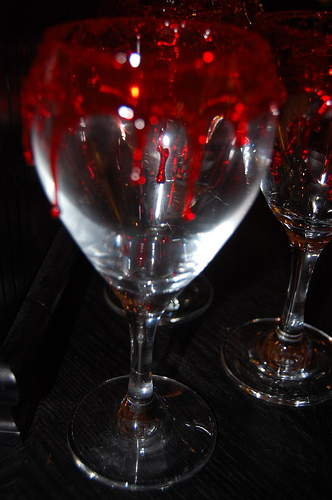FWP:
SETS == DISRUPTION
WINE: {49,1}
How smoothly Ghalib has derailed his own incipient metaphor! As it runs off the end of the tracks, the commentators are left waving signal flags in all directions. It's easy to see how the problem has been set up: the first line simply describes the thrown-stone source of 'this tulip color', without telling us where this color is to be seen. The second line pointedly does not clarify the situation: it reports only that a particular wrong 'suspicion' (that there is wine in the speaker's glass) is held by some 'heedless' person. As Nazm understandably complains, 'But all [the poets] versify [bāñdhnā] a glass as breaking from the damage of a stone. To be damaged and turn red is contrary to reality.' Indeed-- how can a wineglass, when struck by a stone, not break? To describe it as turning red disrupts the incipient metaphor and leaves us confused.
As we cast about for a satisfactory 'connection' between the lines, we're obliged to go back and pay close attention to the word sīlī , which has the basic meaning of a slap or cuff, or specifically a blow with the hand on the back of the neck (see the definition above). This suggests just the kind of blow that a stone might inflict-- on a neck, or a face, or a cheek. The result would surely be, at a minimum, a conspicuous patch of redness on the skin. (On the stoning of madmen, see {35,10}.) We can imagine the mad lover turning up at the fashionable evening party. He looks festive, with a heightened 'tulip' color in his cheeks, and the heedless observer (the beloved? a random, typical guest?) thinks he's been drinking wine along with everybody else. (Or else the observer thinks the 'glass' of his heart has been holding the 'wine' of enjoyment, to make his face so flushed.)
If the 'heedless' observer is wrong in this guess, then it must be true that the lover's 'glass' holds no 'wine' (that is, his heart holds no joy). And the use of the word 'suspicion' [gumān] reinforces the lover's aggrieved tone: 'Although I am innocent of wine-drinking, of joy, of celebratory behavior, I am unjustly suspected-- the heedless one thinks the effects of a thrown stone are the effects of wine!'.
The lover's protest is vehement, and possibly with reason.
For isn't there something suspicious about that tulip color after all? Can't
it also be true that, to the lover, thrown stones are as intoxicating as wine?
We are back once again at the old joy-in-suffering conundrum, the paradoxical
knot at the very center of the ghazal world.

Nazm:
That is, having been damaged by a stone, my glass is turning red, and people think that it is full of wine. But all [the poets] versify [bāñdhnā] a glass as breaking from the damage of a stone. To be damaged and turn red is contrary to reality. In this verse, in the word order the word ḥālāñkih informs us that the author has put the second line first; he has placed the first line after it. (147)
== Nazm page 147